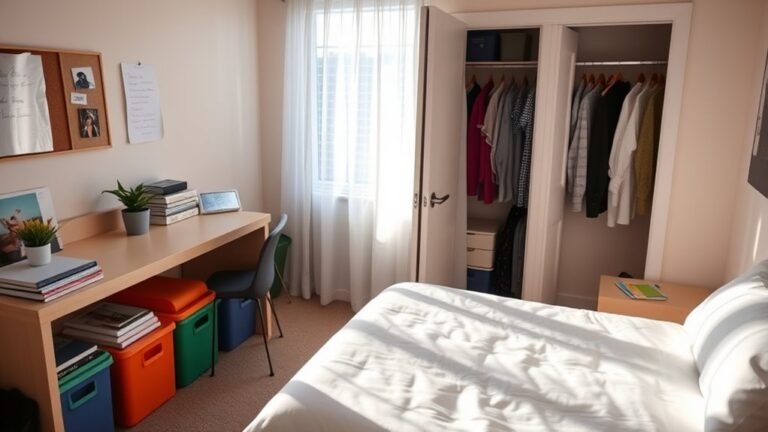How to Clean Your Toys in 10 Minutes
To clean your toys in 10 minutes, first gather mild soap, a soft cloth, and disinfectant wipes. Sort toys by material—plastic, fabric, wood, or electronic—to clean them properly. Wipe hard plastics with soapy water, hand-wash soft toys if needed, and quickly disinfect surfaces. Dry each toy thoroughly and store them in clear bins or labeled containers to keep things organized. Keeping up this routine makes playtime easy and safe. You’ll find tips to simplify this even further ahead.
Gather Your Cleaning Supplies

Before you begin cleaning your toys, you’ll want to gather a few essential supplies. Having the right cleaning supplies on hand makes the process quick and stress-free, leaving you more time to enjoy your space. Start with a mild detergent or gentle soap, a soft cloth or sponge, and a small brush for hard-to-reach spots. You might also want disinfectant wipes for a quick surface clean. If you’re organizing your toys afterward, consider clear bins or labeled containers to keep everything neat and accessible. By prepping your cleaning supplies and planning for toy organization, you create a smooth, efficient cleaning routine that supports your freedom to relax and play without clutter or mess hanging over you.
Sort Toys by Material
Once you have your cleaning supplies ready, sorting your toys by material will make the cleaning process much more effective. Start by separating wooden toys from metal toys, as each requires different care. Wooden toys need gentle cleaning to avoid warping or cracking, so keep them away from excessive water and harsh chemicals. Metal toys, on the other hand, can handle a bit more moisture but watch out for rust. Group plastic, fabric, and electronic toys separately as well, but focus first on wooden and metal ones to prevent damage. By sorting your toys this way, you’ll save time and protect their quality, giving you the freedom to clean efficiently without worry. This simple step sets you up for a smooth, successful cleaning session.
Remove Loose Dirt and Debris

Before giving your toys a thorough cleaning, start by removing any loose dirt and debris. You can shake off dust, gently brush with a soft brush, or wipe them down with a dry cloth. This simple step helps prevent dirt from spreading and makes the next cleaning stage more effective.
Shake Off Dust
A quick shake can do wonders for removing loose dust and dirt from your toys. Before diving into deeper cleaning, gently shake each toy outdoors or over a trash bin to dislodge surface particles. This simple step is one of the easiest toy maintenance tips that saves you time and effort. By regularly shaking off dust, you reduce buildup, making your toys look fresher and last longer. Incorporating this habit into your routine supports effective dust prevention techniques, keeping your play area cleaner without extra work. Remember, this method works best on sturdy toys that won’t break or lose parts when shaken. So, give your toys a quick shake now and then—it’s a quick, practical way to keep dirt at bay and enjoy cleaner toys freely.
Use a Soft Brush
After shaking off loose dust, using a soft brush is a gentle way to remove any remaining dirt and debris from your toys. Soft bristle benefits include protecting delicate surfaces while effectively loosening particles. Choose brush types like a small paintbrush, a makeup brush, or a dedicated toy brush with fine, soft bristles for the best results. Avoid stiff or abrasive brushes that could scratch or damage the toy’s finish. By brushing in light, controlled strokes, you’ll reach nooks and crannies where dust tends to hide, freeing your toys from grime without any harsh scrubbing. This simple step guarantees a cleaner toy and keeps you moving toward your goal—enjoying your toys without the hassle of deep cleaning.
Wipe With Dry Cloth
One simple way to remove loose dirt and debris from your toys is to wipe them with a dry cloth. Choosing the right cloth type makes all the difference—microfiber cloths are ideal because they trap dust effectively without scratching surfaces. When you wipe, use gentle, consistent wipe techniques: long, smooth strokes help lift dirt without spreading it around. Avoid using abrasive materials that could damage your toys or leave lint behind. If you’re dealing with more textured or intricate areas, a soft-bristled brush can complement your wiping, but for quick cleanup, a dry microfiber cloth will do the trick. This method helps you maintain your toys’ condition effortlessly, giving you more freedom to enjoy them without worrying about grime or buildup.
Clean Hard Plastic Toys

You can easily clean hard plastic toys with warm soap and water to remove dirt and grime. After washing, it’s a good idea to disinfect them using a safe solution to keep germs at bay. This simple routine helps guarantee your toys stay both clean and safe for play.
Soap and Water
Cleaning hard plastic toys with soap and water is one of the simplest and most effective methods you can use. Start by choosing a gentle soap type, like a mild dish soap or baby shampoo, to avoid any harsh residues. Use warm water—not too hot—to loosen dirt without damaging the plastic. Fill a basin or sink with this warm, soapy water and let the toys soak briefly. Then, scrub gently with a soft cloth or sponge, focusing on crevices where grime collects. Rinse thoroughly with clean water to remove all soap traces. This quick routine frees your toys from everyday dirt and keeps them safe for play. By sticking to basic soap types and the right water temperature, you maintain your toys’ condition effortlessly and enjoy the freedom of a clean, worry-free playtime.
Disinfecting Techniques
Several effective disinfecting techniques can help you keep hard plastic toys germ-free and safe for children. You can use disinfecting sprays designed specifically for toys, ensuring they’re non-toxic and safe for kids. Simply spray the surface, let it sit for the recommended time, then wipe dry. If you prefer natural solutions, a mix of white vinegar and water works well as a gentle disinfectant. Just spray or wipe the toys with this solution, then rinse and air dry. Avoid harsh chemicals that might leave residues or damage the plastic. Regularly disinfecting your toys not only keeps germs at bay but also gives you peace of mind, letting kids play freely and safely. It’s quick, simple, and effective—just what you need.
Wash Soft and Fabric Toys
Although soft and fabric toys can be delicate, you can safely clean them at home with a few simple steps. Start by checking the care label for any specific fabric care instructions—this helps prevent damage and keeps your toy looking great. For light dirt, a gentle hand wash using mild detergent is ideal. Submerge the toy in lukewarm water, gently squeezing and releasing without wringing to maintain its shape. Rinse thoroughly to remove soap residue. If it’s machine-washable, place the toy in a mesh laundry bag and use a delicate cycle with cold water. Air dry completely, avoiding direct sunlight to preserve colors. Regular fabric care like this not only refreshes your toys but also guarantees effective toy maintenance, extending their lifespan and keeping them safe for play.
Disinfect Toys Safely
How often should you disinfect your toys to keep them safe? Ideally, give them a thorough wipe-down once a week, or more often if they’re shared or used frequently. When disinfecting, choose safe disinfectants that won’t harm kids or pets—look for products labeled non-toxic or use natural cleaning solutions like diluted white vinegar or hydrogen peroxide. These options kill germs without harsh chemicals, giving you peace of mind. Just spray, let sit for a few minutes, and wipe clean with a soft cloth. Avoid bleach or anything too strong, as it can damage toys or irritate sensitive skin. By sticking to safe disinfectants and natural cleaning, you keep toys hygienic and protect your family’s freedom to play without worry.
Dry and Air Out Toys
Once you’ve disinfected your toys, it’s important to dry and air them out thoroughly to prevent moisture buildup that can lead to mold or bacteria growth. Choosing the right drying methods guarantees your toys stay clean and fresh, ready for fun without any health risks. Proper drying also sets the stage for effective toy storage.
| Toy Material | Recommended Drying Method | Tips for Airing Out |
|---|---|---|
| Plastic | Wipe + air dry | Place in a well-ventilated area |
| Fabric/Plush | Pat dry + hang | Avoid direct sunlight to preserve colors |
| Wood | Wipe + air dry | Use a dry cloth and ventilate |
| Rubber | Air dry | Make sure all crevices are dry |
| Electronic Toys | Wipe down + air dry | Keep away from moisture sources |
Using these methods, you’ll keep your toys safe, clean, and ready to enjoy.
Store Toys Properly After Cleaning
After your toys are completely dry and fresh, storing them properly will help keep them clean and in good condition for the next time you use them. Choosing the right toy storage solutions makes organizing toys effortless and frees up space.
- Use clear bins or labeled containers so you can quickly find what you want.
- Store toys in a cool, dry place to prevent damage or mold growth.
- Separate toys by type or size to keep things tidy and easy to access.
- Avoid overcrowding your storage to maintain the toys’ shape and longevity.
With these simple steps, you’ll enjoy a clutter-free space and have your toys ready whenever you want to play. Proper organizing toys means less hassle and more freedom to enjoy them.
Frequently Asked Questions
Can I Use Bleach to Clean My Child’s Toys?
You can use bleach to clean your child’s toys, but it’s important to dilute it properly and rinse thoroughly to guarantee safety. However, if you want gentler options, there are bleach alternatives like vinegar or hydrogen peroxide that work well for toy sanitization. These options let you keep things fresh without harsh chemicals, giving you freedom to choose what feels best for your family while still keeping toys clean and safe for play.
How Often Should I Clean My Toys?
You should follow frequency guidelines based on how often toys are used and who’s playing with them. For everyday use, cleaning once a week works well, but if your child’s sick or toys get shared frequently, increase cleaning frequency. Setting up cleaning schedules helps you stay on top without feeling overwhelmed. It’s all about finding a routine that fits your lifestyle, keeping things safe while giving you freedom to enjoy playtime stress-free.
Are Battery-Operated Toys Safe to Wash?
Washing a battery-operated toy without caution is like trying to swim with your clothes on—it just doesn’t work well. For battery toy safety, never submerge these toys in water. Instead, use a damp cloth with mild soap to wipe them down, avoiding battery compartments. If you want freedom from worry, remove batteries before cleaning. Following these washing methods keeps your toys safe and ready for fun without damage or risk.
Can Cleaning Toys Prevent Allergies?
Yes, cleaning your toys regularly can help reduce allergy triggers like dust, mold, and pet dander that cling to toy materials. By keeping toys clean, you’re minimizing your exposure to these irritants, which can prevent allergic reactions and create a healthier space. Just make sure you use the right cleaning method for each toy material so you don’t damage them while keeping allergens at bay.
What if My Toy Has Electronic Parts?
If your toy has electronic parts, you’ll want to avoid water damage at all costs. Instead of soaking it, use gentle cleaning methods like wiping with a slightly damp cloth or using electronic-safe wipes. Make sure to keep moisture away from openings and let it dry completely before using. This way, you can clean your toy safely without risking damage, giving you the freedom to enjoy it worry-free.






